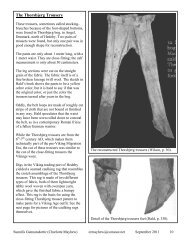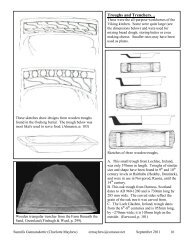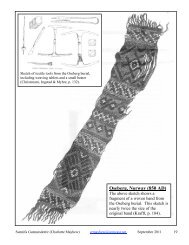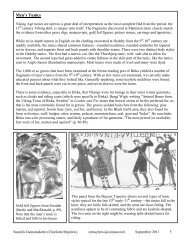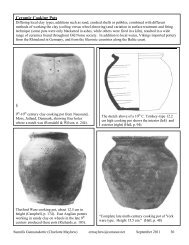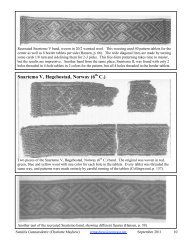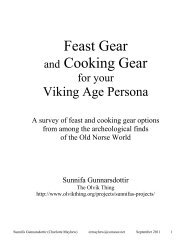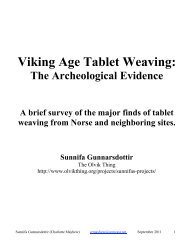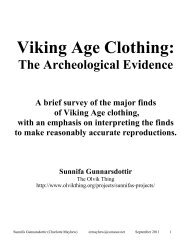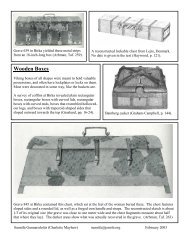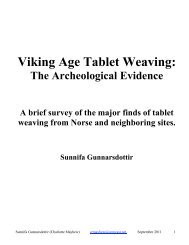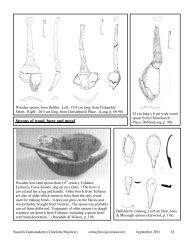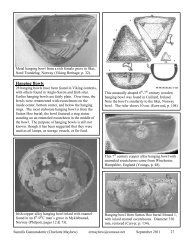Mammen, Denmark (970-971AD) - Olvik Thing
Mammen, Denmark (970-971AD) - Olvik Thing
Mammen, Denmark (970-971AD) - Olvik Thing
You also want an ePaper? Increase the reach of your titles
YUMPU automatically turns print PDFs into web optimized ePapers that Google loves.
Reproduction of the band from Kekomaki, Kaukola, Finland (1200AD), woven in 15 tablets (7 for thecenter pattern and 8 for borders) in two colors in 20/2 wool yarn. The band is made using a variation ofEgyptian diagonals, where each tablet is threaded with 2 threads in 2 colors, with the tablets threaded sothe colors are in pairs. This threading pattern gives a great deal of variety in making up patterns whileweaving. In the case of this band, the weaver followed a repetitive turning sequence (Hansen, p. 71).3 Bands from Finland (11 th- 13 th C.)There are quite a few Finnish tablet weaving finds, but only a few written up in English. The 3 bandsdescribed here share similar threading techniques, although the Kekomaki band used only 2 colors in thewarp threads, and the Humikkala and Eura bands both used 3 colors each.Reproduction in 20/2 worsted weight wool of a band from Humikkala, Masku , Finland, dated to 1,000-1100 AD. This band was very likely a woman’s belt. This reproduction band is woven with 27 patterntablets and 2 border tablets per side, with a free-hand turning pattern (Hansen, p. 70). This band shows atechnique which is common in medieval tablet weaving, which is to have the color used for the figuresremain the same throughout the weaving, while the other color changes, giving the effect of backgroundstripes. Though it is hard to see in the greyscale scan above, the band has alternating red and lavenderstripes running the length of it. The borders are actually alternating strips of red/white andlavender/white which are twined down the length of the band which give the borders a candy cane effect.A similar threading pattern in the center of the band was used on the large stole from the Church of St.Donat, Arlon, Belgium (12 th C.), later in this presentation.The pattern below is from the reconstructed Eura, Luistari, Finland (Grave 56), dress which dates to1000 AD. Note that the pattern reverses itself partway through the band (Lehtosalo-Hilander, p. 50).Sunnifa Gunnarsdottir (Charlotte Mayhew) crmayhew@comcast.net September 2011 30
Kirkkomäki, Turku, Finland (11 th C.)One unique feature of the Kirkkomäkibands is that they have tubularselvedges, which gave the bands morestability. In some cases, the selvedgesare woven in 2 colors, giving them acandy cane striped effect. This is seenin the band from Humikkala, Masku,Finland, shown on the previous page.The selvedges were warp-twined alongthe length of the band with fewreversals (Penna-Haverinen, p. 197).Sketch of the pattern from Kirkkomäki grave 27. Note thatthe patterns in these bands are very like the pattern in theHvilehøj, <strong>Denmark</strong> bands, which indicates a tablet weavingindustry rather than a home craft (Penna-Haverinen, p. 196).This sketch shows the details of the weaving to create the pattern seen above right. The pattern draft justabove on the left also shows the 180 degree reversals as small triangles (Penna-Haverinen, p. 196).Sunnifa Gunnarsdottir (Charlotte Mayhew) crmayhew@comcast.net September 2011 31
Plessenstrasse, Schleswig, Germany (11 th -13 th C.)Reproduction of the 2 color silk band in 100/3 silk. The original was 9mm wide and was made with redand white silk threads with spun-gold brocading thread. 13 tablets formed the central pattern and 5 bordertablets were used per side with 2 white and 3 red, for a total of 23 tablets (Hansen, p. 70). Note that thepattern on this band is very like the pattern on the 10 th century Elisenhof Band 4.Trondheim, Vitenskapsmuseet, Norway (11 th C.)The original band from Trondheim Vitenskapsmuseet (Inventory No. N 89028) was 0.9cm wide and 3.5cmin length. The warp is silk, possibly brown, while the brocading weft was gold S-spun around a corethread. There were 23 tablets, with 3 for each border and 17 in the center pattern area. The tablets werethreaded alternating S and Z so that each pair twined towards each other (Spies, p. 149).Trondheim, Vitenskapsmuseet Weaving DiagramGraph of the Trondheim band’s brocading pattern of repeating diamonds and swastikas. The black dotsrepresent the gold brocading weft, while the white squares represent the ground weave and tie-downs. Thelittle +’s at the edges show where the pattern repeat starts (Spies, p. 149).Sunnifa Gunnarsdottir (Charlotte Mayhew) crmayhew@comcast.net September 2011 32
Church of St.Donat, Arlon,Belgium (12 thC.)The stole (left) andmaniple were wovenin double faced 3/1broken twill. Thebackground stripes areblue and brown, andthe figures are workedin white. It is thoughtthese belonged to St.Bernard, who died in1153 (Collingwood, P.212). This piece hasmany similarities toViking Age tabletweavings, such as thewhite figures workedon a striped 3/1 twillground, similar motifsbut no repeatingpattern, and warptwinedborders.Sunnifa Gunnarsdottir (Charlotte Mayhew) crmayhew@comcast.net September 2011 33
Approximately 1 metre of the tablet woven band was preserved; the entire band was at least twice as long.The band was 4.5cm wide and was woven in yellow, red, orange and green wool, and had a piece of greenstring sewn onto the band as an edging. The sketch above shows the pattern, which repeated its motifs alongthe length of the band. The workmanship of the tablet weaving is unusual, though the motifs are similar toothers found in Europe in the 11 th and 13 th centuries (Nockert, “A Scandinavian Haberget?”, p. 101).Leksand Cloak Band (11 th -13 th C.)The cloak was found buried in the deepest layer of a gravefield containing approximately 160 people underthe porch of a church in Leksand, Dalecarlia, Sweden in 1971. 30 coins found in the gravefield were datedfrom the 10th to the 14th centuries. Only the skull survived in this grave, but based on the other gravegoods, it was believed to be that of a middle-aged woman. The cloak was the only surviving textile. Thecloak is of particular interest because broken-lozenge twill was less common after the 10 th century in Europe.This reproduction of the Leksand cloak band is done in 20/2 worsted wool and 16/1 flax. The band isworked in 4 colors, and the pattern figures are outlined by soumak embroidery (Hansen, p. 71). Hansensuggests that the original band also had soumak weaving outlining the figures, which accounts for theslightly raised look of them. In addition, he believes there were vegetable threads missing, which has leantconfusion to the interpretations of the method of weaving. Hansen conjectures that the band was wovenusing the same technique as the Snartemo V band (Hansen, p. 51). If this is so, it would be evidence of thecontinuation of a complicated weaving technique spanning five centuries in Scandinavia.Another reproduction of the Leksand band showing the difference between weaving with the additionalvegetable warp thread added (the left side of the band), and the weaving without it (right) (Hansen, p. 42).Sunnifa Gunnarsdottir (Charlotte Mayhew) crmayhew@comcast.net September 2011 34
Greenland, <strong>Denmark</strong> 12 th -14 th C.Many Greenland gowns were finished with tablet woven piped seams and edgings (Østergård, p. 104).This sketch shows the same technique used to reinforce the edges of garments. Three examples of thiswere found in mid-14 th century City of London excavations (Crowfoot, Pritchard & Staniland, p. 161).Sunnifa Gunnarsdottir (Charlotte Mayhew) crmayhew@comcast.net September 2011 35
Greenland, <strong>Denmark</strong> 12 th -14 th C.These 50mm x 50mm (5cm x 5cm) bone tablets were found in Russip Kuua, in the Vatnahverfisettlement in Greenland. The meaning of the different markings on the tablets is unclear. Tablet wovenedgings on garments have been found on Greenlandic garments, but no separate tablet woven bandshave been found in Greenland to date (Østergård, p. 113).Sunnifa Gunnarsdottir (Charlotte Mayhew) crmayhew@comcast.net September 2011 36



